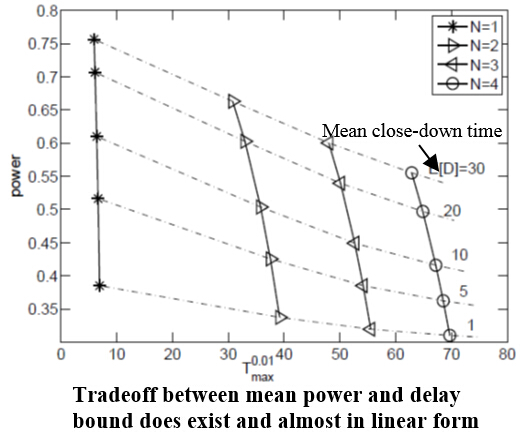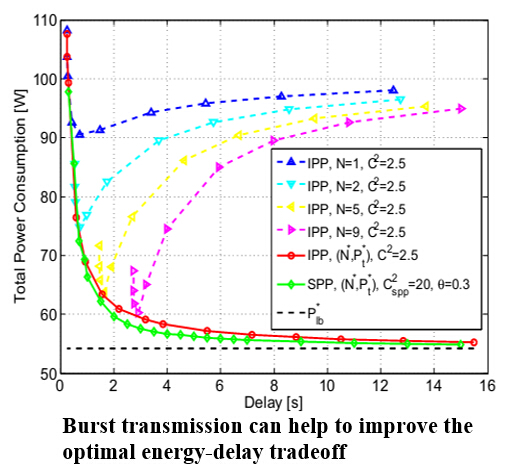Energy-Delay Tradeoff in HCN with BS Sleeping Control
Hyper-cellular Networks with BS Sleeping Control
Base station (BS) sleeping control is one of the effective ways to save energy in hyper cellular networks (HCN), but it may bring extra delay to the jobs. The fundamental questions then arise: how much energy can be traded off by a tolerable delay? Is it possible to have a win-win solution between energy savings and delay? What should be the optimal energy-delay tradeoff?
Optimal Energe-Delay Tradeoff (EDT)
1. Vacation Queueing Models and Analyses[1-2]

Vacation queueing models with setup and close-down times, where a BS enters sleep mode if no jobs arrive during close-down time after the queue becomes empty and starts to setup and then provides services to the accumulated jobs after it takes a vacation (sleeping period). Both single-vacation, multiple-vacation, and N-gated policies are considered. Closed-form formulas are derived to demonstrate the tradeoffs between energy consumption and mean delay by changing the close-down time, setup time, and vacation time.
2. Optimal Base Station Sleeping Control[3-4]
Through theoretical analyses, we show that energy and delay are not always a tradeoff, i.e., longer sleeping time may lead to lower energy consumption, but there may exist an optimal value for the sleeping time that minimizes the mean delay and energy consumption at the same time. It is also shown that the optimal tradeoff is linear when the delay constraint is lower than a threshold and can be achieved by adjusting the close-down time only.
3. Pareto Improvement of EDT[5-6]

The optimal EDT can be further improved by combining the sleeping control with power control of the BS, e.g., cell zooming. In particular, we have found that transmitting power cannot be too low; otherwise, it will reduce the opportunity of BS sleeping. Another way to improve EDT is trying to serve jobs in burst (and then go to sleep) because we have found that “the higher the traffic’s burstiness, the larger the energy saving gain”, which is somewhat surprising. Thus, traffic scheduling (e.g., traffic offloading) is crucial for green communications.
[1] Z. Niu, J. Zhang, X. Guo, S. Zhou, “On the Energy-Delay Tradeoff in Base State Sleep Mode Operation”, 13th Intl. Conf. Commun. Syst. (ICCS), Singapore, Nov., 2012 (invited)
[2] Z. Niu, X. Guo, S. Zhou, P.R. Kumar, "Characterizing Energy-Delay Tradeoff in Hyper-Cellular Networks with Base Station Sleeping Control", IEEE J. Sel. Areas Commun., vol.33, no.4, Apr. 2015.
[3] X. Guo, S. Zhou, Z. Niu, P.R. Kumar, “Optimal Wake-up Mechanism for Single Base Station with Sleep Mode”, 25th IEEE Intl. Teletraffic Congress, Shanghai, Sep. 2013 (Best Student Paper Award)
[4] X. Guo, Z. Niu, S. Zhou, P.R. Kumar, "Delay-Constrained Energy-Optimal Base Station Sleeping Control", IEEE J. Sel. Areas Commun., vol. 34, no. 6, June 2016.
[5] J. Wu, S. Zhou, Z. Niu, “Traffic-aware base station sleeping control and power matching for energy-delay tradeoffs in green cellular networks,” IEEE Trans. Wireless Commun., vol. 12, no. 8, Aug. 2013.
[6] J. Wu, Y. Bao, G. Miao, S. Zhou, Z. Niu, "Base Station Sleeping Control and Power Matching for Energy-Delay Tradeoffs with Bursty Traffic," IEEE Trans Vehicular Technology, DOI: 10.1109/TVT.2015.2434381.
